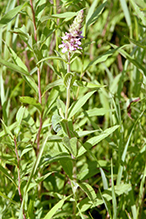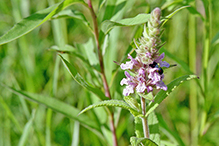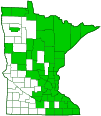smooth hedge nettle
(Stachys tenuifolia)
Conservation • Wetland • Description • Habitat • Ecology • Use • Distribution • Taxonomy
Description |
||
Smooth hedge nettle is a 8″ to 40″ tall, erect, mostly hairless, perennial forb that rises from a rhizome. It often forms colonies. The stems are erect, square, hollow, and usually unbranched. They have scattered, downward-pointing hairs on the ridges of the stem but no hairs between the ridges. The leaves are opposite, thin, oblong or lance-shaped, 2⅓″ to 6″ long, and up to 1½″ wide. They are on leaf stalks, the main leaves on stalks 5 ⁄16″ to 1″ long, the lower leaves on stalks at least ¼″ long. The leaf blades taper to a point at the tip with concave sides along the tip. They are blunt or rounded at the base with the sides coming together at an angle much greater than 90°. The upper and lower surfaces may have hairs along the lower midrib but are otherwise hairless. The margins have rounded, forward-pointing teeth. The inflorescence is a 2″ to 8″ long spike of flower clusters at the end of the stem. Each cluster usually has 6 flowers and is subtended by a small, leaf-like bract. Each pair of opposite flower clusters together form a false whorl. The flowers are ⅜″ to ⅔″ long. They have 5 green, hairless sepals that are fused at the base into a calyx tube 3 ⁄32″ to 3 ⁄16″ long and separated at the end into 5 triangular lobes. There are 5 petals that are fused at the base into a corolla tube about ¼″ long. The petals are pink to white and often have darker pink or reddish splotches near the throat. The calyx tube is always at least ⅔ as long as the corolla tube. The corolla is divided at the end into 2 lips. The upper lip is about 3 ⁄16″ long and ⅛″ wide, hood-like, hairy outside, hairless inside. The lower lip is divided at the tip into 3 lobes, a large central lobe and 2 smaller lateral lobes. There are 4 stamens protected beneath the hood. The fruit is 4 greenish-white, 3-ribbed, 1-seeded nutlets. They turn black when they ripen. |
||
Height |
||
8″ to 40″ |
||
Flower Color |
||
Pink to white |
||
Similar Species |
||
American germander (Teucrium canadense) flowers have a greatly reduced upper lip. Hispid hedge nettle (Stachys hispida) leaf stalks are no more than ⅜″ long. The leaves and calyx are rough with stiff hairs (hispid). Marsh hedge nettle (Stachys palustris) stems have copious hairs both on the ridges of the stem and between the ridges. The petals are pink or lavender with white spots. Woundwort (Stachys pilosa var. arenicola) stems have copious hairs both on the ridges of the stem and between the ridges. The petals are pink or lavender with white spots. |
||
Habitat |
||
Moist. Wet meadows and fields, wooded bottomland, stream banks. Full to partial sun. |
||
Ecology |
||
Flowering |
||
June to August |
||
Pests and Diseases |
||
|
||
Use |
||
|
||
Distribution |
||||
|
Sources |
|||
| 5/9/2023 | ||||
Nativity |
||||
Native |
||||
Occurrence |
||||
|
||||
Taxonomy |
|||
| Kingdom | Plantae (green algae and land plants) | ||
| Subkingdom | Viridiplantae (green plants) | ||
| Infrakingdom | Streptophyta (land plants and green algae) | ||
| Superdivision | Embryophyta (land plants) | ||
| Division | Tracheophyta (vascular plants) | ||
| Subdivision | Spermatophytina (seed plants) | ||
| Class | Magnoliopsida (flowering plants) | ||
| Superorder | Asteranae | ||
Order |
Lamiales (mints, plantains, olives, and allies) | ||
Family |
Lamiaceae (mint) | ||
| Subfamily | Lamioideae | ||
| Tribe | Stachydeae | ||
| Genus | Stachys (hedgenettles) | ||
There is considerable disagreement about the number, the classification, and the common names of Minnesota’s Stachys species and varieties. |
|||
Synonyms |
|||
Stachys glabra Stachys palustris var. macrocalyx Stachys tenuifolia var. perlonga Stachys tenuifolia var. platyphylla Stachys tenuifolia var. tenuifolia |
|||
Common Names |
|||
hedge nettle narrow-leaved betony narrow-leaved hedge-nettle slender betony slenderleaf betony smooth hedge nettle smooth hedge-nettle smooth hedgenettle |
|||
Glossary
Bract
Modified leaf at the base of a flower stalk, flower cluster, or inflorescence.
Calyx
The group of outer floral leaves (sepals) below the petals, occasionally forming a tube.
Corolla
A collective name for all of the petals of a flower.
Rhizome
A horizontal, usually underground stem. It serves as a reproductive structure, producing roots below and shoots above at the nodes.
Sepal
An outer floral leaf, usually green but sometimes colored, at the base of a flower.
Visitor Photos |
|||||
Share your photo of this plant. |
|||||
| This button not working for you? Simply email us at info@MinnesotaSeasons.com. Attach one or more photos and, if you like, a caption. |
|||||
|
|||||
MinnesotaSeasons.com Photos |
|||||
Plant |
|||||
 |
|||||
Inflorescence |
|||||
 |
|||||

Visitor Videos |
|||
Share your video of this plant. |
|||
| This button not working for you? Simply email us at info@MinnesotaSeasons.com. Attach a video, a YouTube link, or a cloud storage link. |
|||
Other Videos |
|||

Visitor Sightings |
|||||
Report a sighting of this plant. |
|||||
| This button not working for you? Simply email us at info@MinnesotaSeasons.com. Be sure to include a location. |
|||||
|
|||||
MinnesotaSeasons.com Sightings |
|||||

|
Created: Last Updated: © MinnesotaSeasons.com. All rights reserved. |


